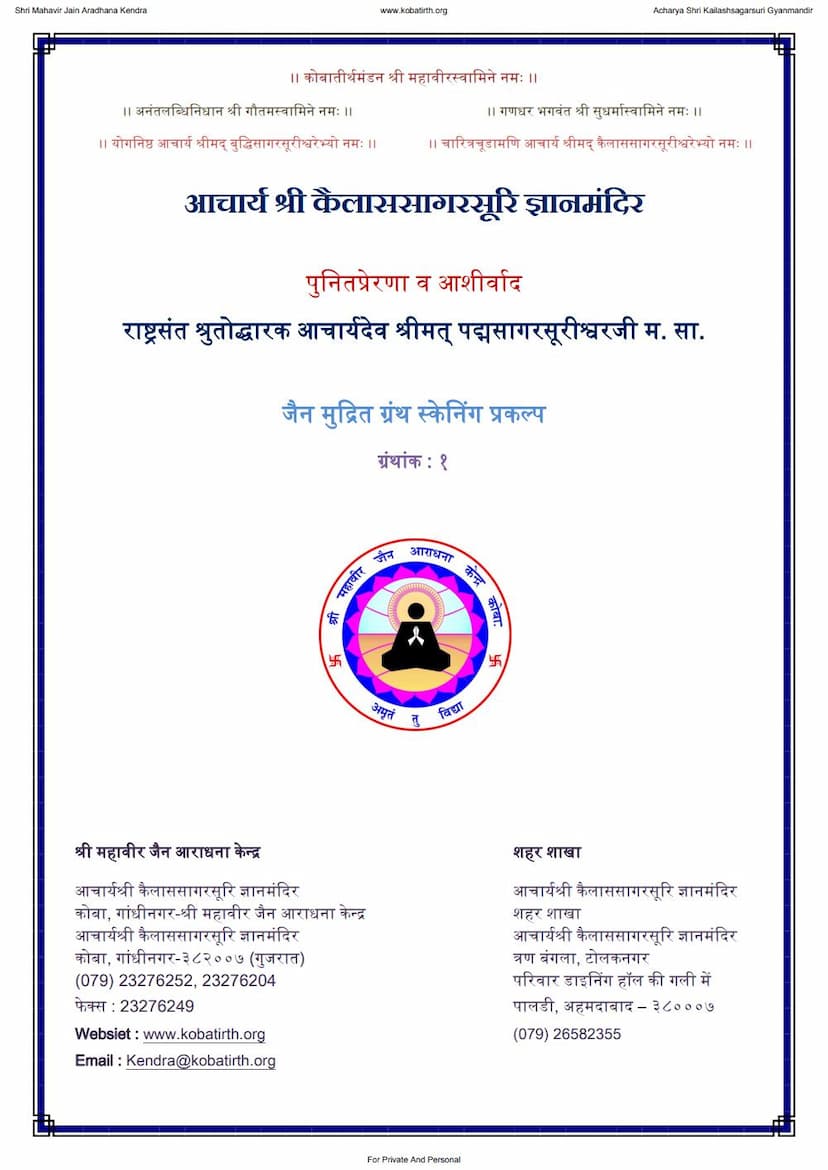Gobhiliya Gruhya Karm Prakashika
Added to library: September 1, 2025

Summary
The text provided is a comprehensive guide to Grihya rituals, likely relating to household ceremonies and observances based on the Gobhila Grihya Sutras. The title "Gobhiliya Gruhya Karm Prakashika" itself suggests this. Here's a summary based on the provided pages:
Overall Purpose:
The text serves as a detailed manual or commentary explaining various household rituals and practices, primarily following the Gobhila Grihya Sutras. It aims to shed light on (Prakashika) these rites and their execution. The preface indicates it was written for the "Bala Bodha" (understanding of the simple/young), suggesting it's intended to make these complex rituals accessible.
Key Sections and Rituals Covered (Based on the Table of Contents and initial pages):
The table of contents on page 5 and subsequent pages outlines a vast array of rituals. Here's a breakdown of the major themes:
-
Foundational Concepts:
- Sakal Karma Paribhasha (General Definition of Actions): Likely covers basic principles of ritual purity, eligibility, and timing.
- Pravana Lakshanam (Characteristics of Pravana): Possibly related to specific observances or offerings.
- Sammil Lakshanam (Characteristics of Sammil): Likely refers to fuel sticks used in rituals.
- Pavitra Lakshanam (Characteristics of Pavitra): Refers to sacred thread or purification items.
- Kshiragra Homa Lakshanam (Characteristics of Kshiragra Homa): A specific type of ritual fire.
- Panchamrta Lakshanam (Characteristics of Panchamrita): Five nectars used in worship.
- Anugupta Av Lakshanam (Characteristics of Anugupta Av): Likely related to veiled or secret rituals.
- Prajapati Vachanam (Words of Prajapati): May refer to specific mantras or pronouncements.
- Manthana Kal (Time of Churning): Likely related to the creation of fire.
- Deva Yojana Lakshanam (Characteristics of Devayojana): Possibly related to invoking deities.
- Dam patyam Niyamah (Rules for the Couple): Observances for married couples during rituals.
-
Agni Karyas (Fire Rituals):
- Adhana Prayoga (Ritual of Establishing Fire): This is a significant section, detailing the process of establishing the sacred household fire.
- Kunda Nirmana (Construction of the Sacrificial Pit): Describing the structure for the fire.
- Darsha Purnamasa Sthalipaka (Rituals on New Moon and Full Moon Days): These are fundamental Vedic sacrifices.
- Sayam Prata Hopasanam (Evening and Morning Fire Worship): Daily rituals.
- Vaishvanara Sthalipaka Prayoga (Ritual for Vaishvanara): Offering to the universal fire.
- Nav Yagyaadi Lopa (Omission of Nine Great Sacrifices): Dealing with situations where these sacrifices are missed and the atonement required.
- Punar Adhanam (Re-establishment of Fire): Procedures for re-establishing the sacred fire if it goes out.
- Vivaha Kalika Adhanam (Establishing Fire for Marriage): Specific procedures related to marriage.
- Vichchhinna Adhana Prayoga (Ritual for Interrupted Fire): Procedures when the continuity of fire is broken.
-
Samskaras (Life Cycle Rituals):
- Garbadhana Prayoga (Ritual of Conception): Ceremonies related to conception.
- Pumsavana Prayoga (Ritual for Male Offspring): Ceremonies performed to ensure a male child.
- Simantonnayana Prayoga (Ritual of Hair Parting): A ceremony for pregnant women.
- Jatakarma Prayoga (Ritual after Birth): Ceremonies performed immediately after a child's birth.
- Anuprashana Prayoga (Ritual of First Solid Food): The ceremony of giving the first solid food.
- Chandradarshana Prayoga (Ritual of Moon Viewing): Ceremony involving viewing the moon after birth.
- Namakarana Prayoga (Ritual of Naming the Child): Ceremony for naming the child.
- Chudakarana Prayoga (Ritual of Tonsure): The ceremony of cutting the hair.
- Upanayana Prayoga (Ritual of Investiture with the Sacred Thread): The ceremony of initiating a boy into Vedic studies.
- Vahni Homarambha (Beginning of Fire Rituals): Likely related to the Upanayana or subsequent studies.
- Samashaniya Sthalipaka (Meal of the Wife): Possibly related to post-marriage rituals.
- Vivaha Prayoga (Marriage Ritual): Details of the marriage ceremony.
- Shukra Akhyam Pumsavanam (The Purvaka Pumsavana): Another mention of the Pumsavana ritual.
- Devata Yaga Prayoga (Ritual of Worshiping Deities): General deity worship.
-
Sacrificial Implements and Materials:
- Sruva Sruk Lakshanam (Characteristics of Sruva and Sruk): Types of ladles.
- Mekshana Lakshanam (Characteristics of Mekshana): Likely a stirring or clearing implement.
- Chamas Lakshanam (Characteristics of Chamas): A vessel for offerings.
- Idhmana Lakshanam (Characteristics of Idhmana): Fuel sticks.
- Samidha Lakshanam (Characteristics of Samidha): Fuel sticks.
- Panchamrita Lakshanam (Characteristics of Panchamrita): Mentioned again, likely referring to materials.
- Kshipra Hama Lakshanam (Characteristics of Kshipra Homa): A quick fire ritual.
- Pratyashitta Pramanam (Measurement of Atonement): Details on remedial rituals.
- Dakshina Danaadi (Giving Donations): The importance and manner of offering donations.
-
Atonement and Remedial Rituals (Pratyashitta):
- Gobhila Ukta Pratyashitta (Atonement mentioned by Gobhila).
- Parishishta Ukta Pratyashittani (Atonements mentioned in the Parishishta).
- Anugata Pratyashitta (Consecutive Atonements).
- Naimittika Pratyashittani (Occasional Atonements).
-
Specific Rituals and Festivals:
- Astaka Prayoga (Rituals of Astaka): Monthly observances.
- Madhyama Ashtaka (Middle Ashtaka).
- Anvashtakya Prayoga (Ritual after Ashtaka).
- Pinda Pitru Yajna Prayoga (Ritual of Offering Pindas to Ancestors).
- Shaka Ashtaka Prayoga (Vegetable Ashtaka).
- Rina Nivitti Prayoga (Ritual for Debt Repayment).
- Halabhgioya Prayoga (Ritual related to Ploughing).
- Indrani Sthalipaka Prayoga (Sthalipaka for Indrani).
- Ashvayuji Karma (Ritual of Ashvayuja).
- Navayajna Prayoga (Ritual of Nine Yajnas).
- Agrahayani Prayoga (Ritual of Agrahayani).
- Prasadkara Karmani (Rituals for Bestowing Grace).
- Kshudrapashu Swastyayan (Atonement for Small Animals).
- Madhu Pank Prayoga (Ritual of Honey Mixtures).
Author and Publisher:
The book is authored by "Subramhanya" and published by "Subramhanya."
Historical Context:
The publication date is indicated as Vikram 1643, which corresponds to 1886 CE. This suggests the text is a traditional commentary or compilation that was printed in the late 19th century.
Overall Impression:
This appears to be a highly detailed and authoritative text on the Gobhila Grihya Sutras, providing practical instructions and explanations for a wide range of household religious observances. The extensive table of contents indicates a thorough treatment of each ritual, likely including mantras, materials, timings, and specific procedures.